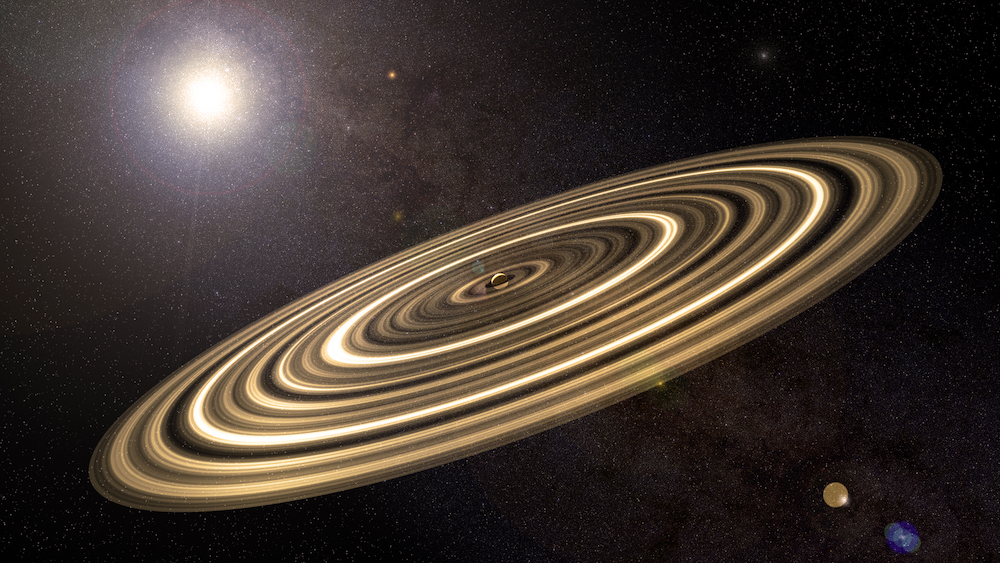January 09, 2021
Meanwhile: At Alpha Centauri
This story actually transpired a couple of weeks ago but I have been waiting for the inevitable debunking. Now one of the Brickmuppet's Crack Team of Science Babes is here to inform us how that went...



"The debunking is not going quite as smoothly as expected".
Oh dear.
Allow me to explain...
A few weeks ago, radio astronomers detected an odd radio signal that seemed to come from from the nearby Alpha Centauri system, the 3 closest stars to Earth.
That's bloody coincidental, so while the press was being their usual calm selves, the scientists did what they always do when they hear an 'extraterrestrial signal', they set about trying to figure out what Earth radio signal they had mistakenly picked up.
Well, weeks later there have been some developments...sort of.
Basically all known terrestrial radio signals have been eliminated as being this.
As I understand it, the signal hasn't changed much in bearing (relative to the sun), which one would expect if it to do if it were being broadcast from inside the solar system. Moreover, this turns out not to be a particularly weak signal by the standards of radio astronomy, quite the opposite in fact, and after adjusting their readings and analyzing their parallax, they've narrowed it down to coming from the direction of Proxima Centauri, a red dwarf that is the closest of the three stars in Alpha Centauri and the closest star to Earth.
The chances of the first SETI success involving the closest star in the sky is....well, the odds of THAT seem dubious.
However, this signal is strange, and is stubbornly defying debunkery. An inability to, as of yet, debunk something that is vanishingly unlikely is NOT the same as confirmation. However, this has slipped out of the realm of press hype and into the realm of 'interesting'.
There's a good overview of this conundrum here:
Interestingly, the signal doesn't appear to be data...it's a monotone signal, like a dial tone...or a beacon.
Proxima is now known to have at least 2 planets and an asteroid/dust belt.
One of the planets, (Proxima Centauri B) is in the theoretical habitable zone from the star. However that habitable zone is very close to the star. Proxima's a small star, a tad bigger than Jupiter (though much more massive) and it's not a calm star like ours. It flares quite spectacularly. In fact it has flares that are bigger than those spewed out by our sun.
Any planet in the "habitable zone" of this dinky little star is going to get bombarded by star farts, and would require a massive atmosphere similar to Venus, and/or a terribly strong magnetic field to keep its atmosphere from being stripped away.
Note too that "habitable zone" is a bit of a provincial and vague term. Venus, Earth and Mars are in our sun's habitable zone, but only one of them is habitable by humans.
The planet in that system which has gotten the most attention is the aforementioned Proxima Centauri B, in part because it is in the habitable zone and in part because it was discovered first. It has a mass somewhere between 1.7 and 1.6 times that of Earth and an estimated surface gravity, according to Wikipedia of between .95 and 1.1 g. It's a bit bigger and somewhat more massive than Earth. Assuming it has an atmosphere, it's probably colder than Earth...but that's a big assumption, because it's so close to its star that its getting blasted by solar wind and radiation, that, in the absence of a strong magnetic field would have stripped away the atmosphere long ago and sterilized the husk.
We have some experience with the magnetic fields of roughly Earth-size rocky planets, having no less than four of them in the general vicinity. Only one of them, has a useful magnetic field. Mars has one that only extends above the planetary surface in the tropics. Venus has a weak magnetosphere caused by the impact of solar wind on its upper atmosphere, Mercury, which is about the size of the moon (but as massive as Mars) has a very weak field, and Earth has about the second strongest magnetic field in the solar system after Jupiter. Earth's anomalously strong field is actually on par with the other gas giants like Saturn. It is hypothesized that this is due to tidal forces coming from the moon and the fact that Earth still spins on its axis fairly quickly.
As we noted a while back, any planet orbiting as close to its star as Proxima b is likely to be tidally locked, that is, it's likely to orbit once per rotation (like the moon is to Earth). However, In the embedded video there is speculation that it might be in resonance, perhaps with the other, recently discovered, planet (Proxima Centauri C) much as Mercury is in resonance with Jupiter. It is unclear if this is based on models or wishful thinking, but this would at least mean that it would have a day/night cycle. However, even generously granting that possibility, it likely still does not rotate fast enough to generate a sufficient magnetic field to protect it. There is also a data artifact noted in passing on page 8 of this paper that opens the remote possibility that the planet might have a moon (how that could possibly work so close to the star is unclear). There is a video discussion of this planet and the solar system in general here.
The study confirming Proxima b also indicated there might be another, smaller planet with an orbital period of 5.15 days (Noted on page 7 of the previous paper) but Proxima d is, as yet, unconfirmed.
The only other planet confirmed to be in the system in the system, Proxima Centauri C is either a small ice giant (would that be an ice orc?) , or a big rocky world. It is quite frigid and fairly far from the star, being outboard of what appears to be a dust or asteroid belt. This is all based on inferences from the wobble and red-shift of the star, but, recently astronomers were actually able to take a direct picture of Proxima C. While this dark frigid world elicits little interest from those looking for life signs, the ability to directly take a picture of a planet in another solar system is cool indeed. So what does this boring thing look like?
Yes the bigger planet in the system we are "getting signals from" is 'glowy', way bigger than it should be, and appears to be vastly less dense than a planet.
Wow.
One possibility is that this planet has a massive ring system, that, like those of Saturn and Chariklo, is coated in highly reflective ice.

Uncredited NASA artist's conception of Proxima-C via
For reasons of propriety, we will, of course, dismiss out of hand the notion that Proxima C is an alien megastructure.
"Science Babe" is actually Rio Futaba as imagined by Uname.
Posted by: The Brickmuppet at
11:37 AM
| Comments (7)
| Add Comment
Post contains 1185 words, total size 11 kb.
<< Page 1 of 1 >>
41kb generated in CPU 0.0167, elapsed 0.0854 seconds.
68 queries taking 0.0724 seconds, 276 records returned.
Powered by Minx 1.1.6c-pink.
68 queries taking 0.0724 seconds, 276 records returned.
Powered by Minx 1.1.6c-pink.









